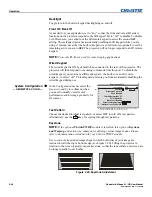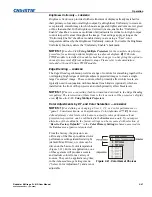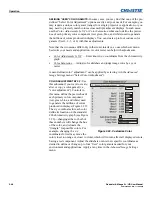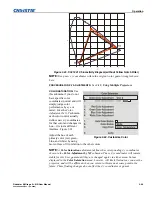
Operation
Roadster & Mirage S+/HD User Manual
3-35
020-100002-04 Rev. 1 (12-2008)
frame is lost or “dropped”, this value will cycle to maximum and jump to minimum
and then repeat, indicating that the frame input is no longer equal to the output. If the
signal is not locked, the values will change erratically; you can adjust the Frame
delay to attempt a correction.
NOTE:
See separate Using 3D in Mirage manual provided for more information.
FRAME DELAY —
Set the number of lines delayed between the input signal and its
appearance on screen, keeping in mind that projector processing always
adds one
frame of delay
to the frame delay setting. For applications such as simulation, where
the feeling of “real time” image response is a priority, a minimum setting is usually
preferable. For projectors capable of 3D (stereographic) applications where
alternating left-right frames must be synchronized with the corresponding L/R
shutters in 3D glasses, a total frame delay setting of two (or multiple of two) may be
more useful. If set too high or low, frame locking will not be possible—most sources
require approximately 50 lines of delay to ensure frame locking.
NOTE:
See separate Using 3D in Mirage manual provided for more information.
DARK INTERVAL
—
Adjust Dark Interval to artificially increase the amount of dark
time between displayed frames for stereographic 3D images. Higher settings provide
more time for shutters in 3D glasses to open/close, ensuring that each eye sees the
full display intended for it. Symptoms of cross talk and/or color artifacts can indicate
need for adjustment. The Dark Interval range of adjustment depends on the vertical
frequency of your source—the higher the frequency, the smaller the range.
NOTE:
See separate
Using 3D in Mirage
manual provided for more information.
3D STEREO SYNC LOCKING
—
This option defines 1) whether or not the incoming
stereographic 3D signal locks to the vertical sync output so that signals are
synchronized, and 2) whether or not the 3D frames must be inverted, i.e. swapped
left-with-right. The correct setting ensures that the projector’s 3D display of left/right
frames is synchronized with the rest of the 3D system components so that the
intended eye sees the left/right image data. Select the option corresponding to your
3D source connections and timing, and use only if the
Mirage 3D Stereo Sync Cable
is connected between the projector’s GPIO port and a server. Keep this adjustment
OFF (default) when you are not using the
Mirage
3D Stereo Sync Cable.
With your sync cable and, if desired, emitter connected as described in the
Using 3D
in Mirage
manual
, select the option suited to your 3D configuration (see above). If
Frame Delay is two (or 0), do not invert; if frame delay is one or three, invert.
Generally, an “Unlocked” setting is synchronized with the incoming L/R signal
rather than the vertical sync output, and may be needed only with multi-projector
installations in which the vertical sync outputs vary.
NOTE:
See separate
Using 3D in Mirage
manual provided for more information.
















































